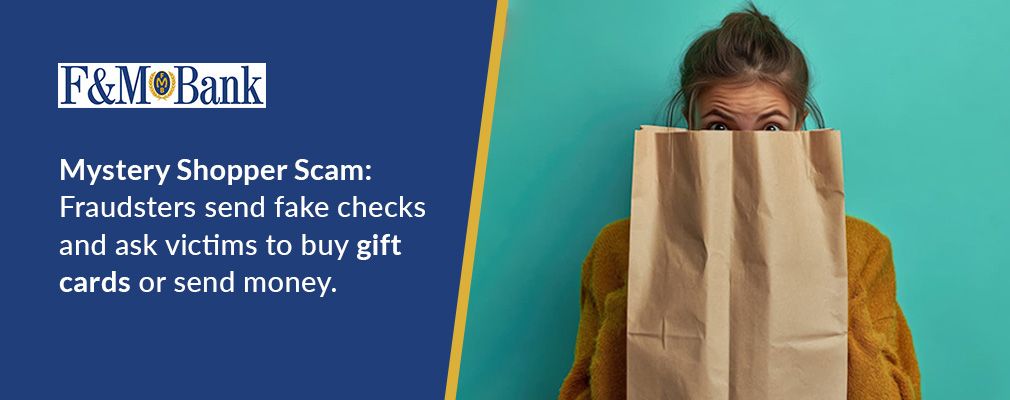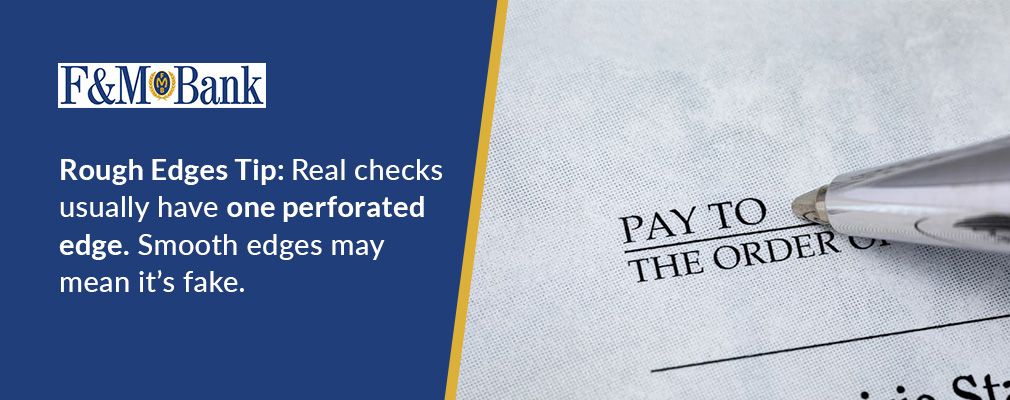Can You Spot a Fake Check?
05/01/2025
By: F&M Bank Oklahoma

Can You Spot a Fake Check?
While many businesses and individuals rely on credit cards and electronic payments these days, paper checks remain popular, especially among scammers.
Earlier this year, the FBI and the U.S. Postal Service (USPS) warned that check fraud is on the rise, with a significant portion of it occurring through mail theft, as criminals steal checks from mailboxes and USPS collection bins. Suspicious activity reports related to check fraud nearly doubled from 2021 to 2023.
Check scams are popular among criminals because they know that federal regulations require banks to make the funds from a check available within days but clearing a check can take weeks. This means criminals can disappear with their illegally obtained funds before the victim realizes they were scammed. Businesses and consumers must remain vigilant against fake checks and checking scams.
What to Do If You Receive a Suspicious Check
If you’re at all suspicious about whether a check is legitimate. Try calling the bank that issued the check to verify the account. Look the number up yourself, rather than using one that may be printed on the check. Avoid depositing the check until you can verify that it’s legitimate.
If you’ve deposited a check that could be fraudulent, wait until it clears your account before you try to use the funds, send any merchandise, or make a wire transfer. Your bank could make some or all the proceeds from a check available within one or two business days, but if the check was issued by another bank, it could take two weeks or more for the check to clear.
Any signs of check fraud should be reported to your bank immediately, even if you’re just suspicious that a check could be forged. Our people are trained to look for signs of fraud, and we can help you figure out if it’s fake.
If you’re the victim of check fraud or any other kind of financial fraud, you should also report it to the Federal Trade Commission and your state’s attorney general.
Common Fake Check Scams
There are several types of fake checking scams. Some of them involve a scammer creating and sending a fraudulent check to a victim. In other cases, thieves will take legitimate checks and use them to commit fraud. A stolen and altered check could be deposited by fraudsters themselves or sold to an accomplice who deposits the checks. Either way, a scammer’s goal is to take someone else’s money and disappear before the victim or law enforcement realizes it.
The “Mystery Shopper” Scam
A scammer convinces you to work as a mystery shopper. They send you a check, which you deposit into your account. Your first assignment is to evaluate retailers that offer gift cards, money orders, and wire transfers. You send money and gift cards to a scammer’s account, and they disappear. You later find out the check was no good, and whatever you sent to the scammer is lost.

The Personal Assistant Scam
A scammer “hires” you to be a personal assistant. They send you a check, tell you to buy gift cards, and send their information and PIN codes to your “boss.” They cash in the gift cards, and you’re left with nothing but a fraudulent check in your bank account.

Lottery and Sweepstakes Scams
Someone claims you won a sweepstakes, lottery, or contest. They send you a check and tell you to send money to cover taxes, shipping and handling, or processing fees. Of course, the check is fraudulent.
The Overpayment Scam
A business receives a check from a scammer who claims they “accidentally” sent too much money and asks the recipient to send them a refund, instead of the check itself. In many cases, the scammer will impersonate someone the victim knows, such as a friend, family member, or business associate. The victim deposits the check and transfers the “excess” money to the scammer, but later finds out the check was a fraud.
Check Washing Scams
Someone steals a legitimate check and physically alters it to change the name of the recipient and the financial amount.
Check Cooking Scams
Someone steals a check, scans it to create a digital image, manipulates it to change the recipient and the amount, and creates several phony checks using high-tech printers. In some cases, scammers will create several checks in small amounts, hoping they won’t be noticed the way a larger check would.
How to Spot a Fake Check
Advanced printing methods can make it hard to discern the real checks from the fake ones, but here are some things to watch out for.
Rough Edges
Take a close look at a check that you know is legitimate, such as one of your own. Legitimate personal and business checks are typically perforated with at least one rough edge. Any check you receive that has four smooth edges is probably bogus.

Unusual Numbers
Most bad checks come from accounts that are less than a year old. A low number on a check doesn’t necessarily mean that it’s a bad check, but it’s a reason to be suspicious. Take a close look at where the number is located. It should be in the upper right-hand corner of the check. If it’s in a different place, it’s likely a scam. Also make sure the check number is matches the number in the MICR at the bottom of the check. If you receive more than one check from the same source, look for any check numbers that are out of order. An older check should have a lower check number than a check that was issued after it. You should also watch out for multiple checks that have the same number.
Look At the MICR Line
Every check has a Magnetic Ink Character Recognition (MICR) line at the bottom that can be read by check reading devices. It contains the bank’s routing number, the check holder’s account number, the check number, and a couple of symbols. These characters should all be printed with magnetic ink that appears dull and flat. If the MICR printing appears shiny or has raised characters, or if there’s no MICR line at all, the check is fake.
Check the Routing Codes
While you’re examining the MICR line, make sure the routing code is correct. It’s a nine-digit number on the check’s bottom left corner that indicates the location of the bank that issued the check. The Federal Reserve has a list of Check Services Routing Numbers online. You can also search for a bank’s routing numbers. If a routing number doesn’t line up with the bank’s location, it could be a fake.
Read the Memo
While checks have a “memo” line where people can note the reason for the check, a business or financial institution is unlikely to put any information there. While some small businesses have one checkbook, most companies have different accounts for different expenses, such as one account for issuing paychecks and another for paying vendors. It’s unlikely that you would see a check with a memo line that says “payroll” or some other term. If a check does have a memo, it could be a fake.
The Bank Logo and Address
Every check issued by a bank will have its logo on the front and may include its business address or website. Take a close look at the logo and make sure it’s legit by comparing it to the logo on the bank’s website. If it appears fuzzy or faded, it could have been copied from a real check or taken from the website. If it has an address, an Internet search can reveal whether it’s the real address for that bank.
Paper and Ink
Take a close look at your own personal or business checks and feel the thickness of them. Legitimate checks are printed on high-quality matte (not glossy) paper. If you receive a check that feels more like the paper you use for your printer, then it’s probably fake. The ink itself should be high-quality indelible ink that’s not easily removed. If you run a damp fingertip across the check and the ink runs or smears, it’s probably fake.
Mismatched Lettering
A printed check should have the same typeface for the recipient, the dollar amount, the date, and the signature. If they appear to be in different fonts or were printed with different inks, the check may have been altered.
Stains and Discolorations
Hold the check up to a light source and see what shines through. If there are any stains or discolorations, it could be because a scammer used chemicals to remove some of the ink and alter the check.
Other Signs to Watch out for
Many clues can reveal an altered or phony check. These include:
• Most business checks and all government checks have the recipient’s name and dollar amounts printed instead of handwritten.
• Printing mistakes, such as spelling errors or typos,
• The words “VOID” or “non-negotiable” are on the check.
• It lacks an authorized signature or has a signature that looks irregular.
• The written amount of the check and the numbers in the dollar box should be for the same amount. If they’re not, a fraudster may have made a mistake when altering a check.
Stay Vigilant against Check Fraud
If you have any questions about avoiding check fraud, please contact us online or connect with one of our branches in Oklahoma City and the surrounding area. You can also check out our Fraud Center page for more information about avoiding scams.
